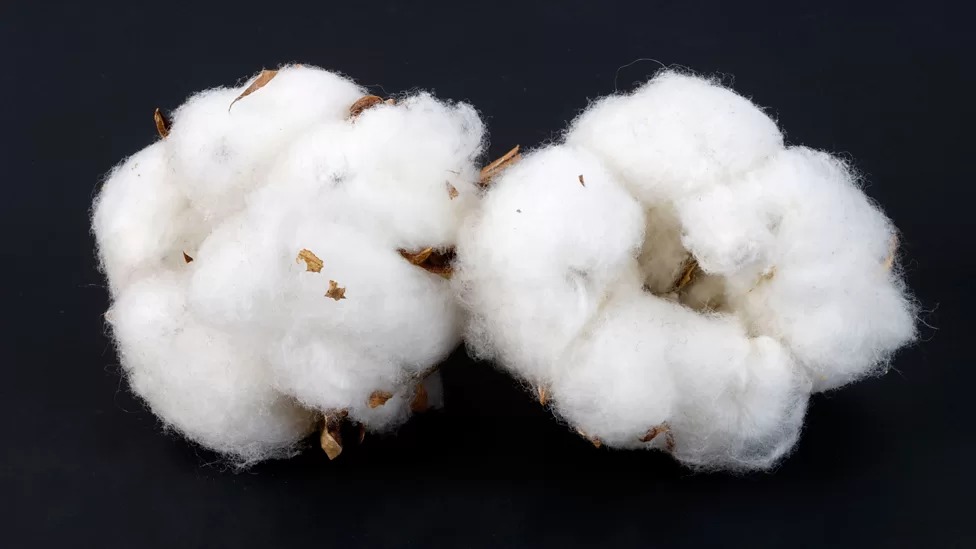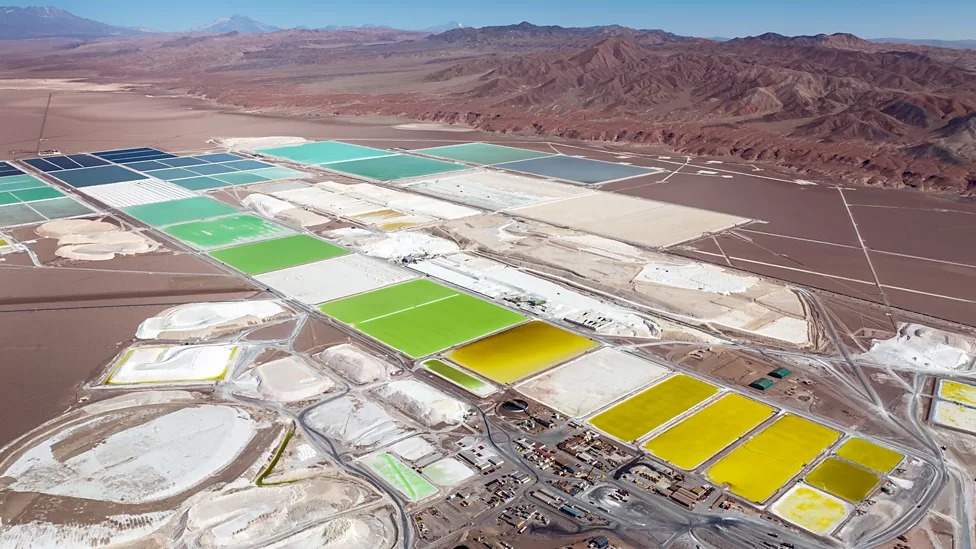 未来电池:棉花和海水如何为我们的设备提供动力
未来电池:棉花和海水如何为我们的设备提供动力
Batteries of the future: How cotton and seawater might power our devices
译文简介
开采电池所需的锂矿和其他矿物对环境造成了日益严重的破坏,但我们周围存在很多替代材料。
正文翻译

Pyrolysing cotton at high temperatures can produce carbon with a structure that makes it ideal for use in batteries.
棉花在高温下热解会产生碳,其结构使它适用于电池。
Zip. The power's out. But on a street in India, there's a cash machine still happily dispensing banknotes. Thanks, in part, to burnt cotton. For this cash machine has a backup battery inside it – a battery that contains carbon from carefully combusted cotton.
突然间停电了,但印度街头的一台自动取款机仍在愉快地出钞。这在一定程度上归功于燃烧的棉花,因为这台自动取款机内部装有备用电池,该电池含有精心燃烧的棉花所产生的碳。
突然间停电了,但印度街头的一台自动取款机仍在愉快地出钞。这在一定程度上归功于燃烧的棉花,因为这台自动取款机内部装有备用电池,该电池含有精心燃烧的棉花所产生的碳。
"The exact process is secret, to be honest with you," says Inketsu Okina, chief intelligence officer at PJP Eye, the Japanese firm that made the battery. He's not joking, either. "The temperature is secret and atmosphere is secret. Pressure is secret," he continues, cagily.
“跟你说实话,具体工艺是商业机密”,制造这种电池的日本公司PJP Eye的首席情报官Inketsu Okina说道。而且他没开玩笑。“温度是机密,环境条件是机密,气压是机密,”他守口如瓶地补充道。
“跟你说实话,具体工艺是商业机密”,制造这种电池的日本公司PJP Eye的首席情报官Inketsu Okina说道。而且他没开玩笑。“温度是机密,环境条件是机密,气压是机密,”他守口如瓶地补充道。
Okina does say that a high temperature is required, above 3,000C (5,432F). And that 1kg (2.2lbs) of cotton yields 200g (7oz) of carbon – with just 2g (0.07oz) needed for each battery cell. The firm bought a shipment of cotton in 2017 and still hasn't used all of it, says Okina.
Okina还说需要3000摄氏度(5432华氏度)以上的高温。1公斤(2.2磅)棉花可以产生200克(7盎司)碳,每块电池仅需2克(0.07盎司)碳。Okina表示,该公司在2017年购买了一批棉花,但至今仍未用完。
Okina还说需要3000摄氏度(5432华氏度)以上的高温。1公斤(2.2磅)棉花可以产生200克(7盎司)碳,每块电池仅需2克(0.07盎司)碳。Okina表示,该公司在2017年购买了一批棉花,但至今仍未用完。
In the batteries developed by the company, together with researchers at Kyushu University in Fukuoka, Japan, carbon is used for the anode – one of the two electrodes between which flow ions, the charged particles in batteries. Ions move in one direction when the battery is charging and in the other direction when it releases energy to a device. The majority of batteries use graphite as an anode but PJP Eye argues their approach is more sustainable, since they can make anodes using waste cotton from the textile industry.
在该公司与日本福冈九州大学的研究人员联合开发的电池中,阳极是用碳制造的,离子作为带电粒子在两极之间流动。当电池充电时,离子向一个方向迁移,当电池向设备释放能量时,离子向另一个方向迁移。绝大多数电池的阳极是用石墨制造的,但PJP Eye公司认为他们的方法更具可持续性,因为可以利用纺织业的棉花废料来制造阳极。
在该公司与日本福冈九州大学的研究人员联合开发的电池中,阳极是用碳制造的,离子作为带电粒子在两极之间流动。当电池充电时,离子向一个方向迁移,当电池向设备释放能量时,离子向另一个方向迁移。绝大多数电池的阳极是用石墨制造的,但PJP Eye公司认为他们的方法更具可持续性,因为可以利用纺织业的棉花废料来制造阳极。
With huge demand for batteries expected in the coming years, propelled by the rise of electric vehicles and large energy storage systems, some researchers and businesses are frantically developing possible alternatives to the lithium ion and graphite batteries that are commonplace today. Like PJP Eye, they argue we could be using much more sustainable and widely available materials for battery production.
在兴起的电动汽车和大型储能系统的推动下,预计未来几年将有巨大的电池需求。除了当今广泛使用的锂电池和石墨电池,一些研究人员和企业正在拼命研发潜在的替代品。就像PJP Eye公司一样,他们也认为可以使用更具可持续性、更易获取的电池生产材料。
在兴起的电动汽车和大型储能系统的推动下,预计未来几年将有巨大的电池需求。除了当今广泛使用的锂电池和石墨电池,一些研究人员和企业正在拼命研发潜在的替代品。就像PJP Eye公司一样,他们也认为可以使用更具可持续性、更易获取的电池生产材料。

Growing demand for electric vehicles means sustainable sources for high-performance battery materials will be needed
电动汽车的需求日益增长,这意味着将来需要可持续的高性能电池材料来源。
Lithium mining can have a considerable impact on the environment. Extracting the metal requires large amounts of water and energy, and the process can leave huge scars in the landscape. The recovered lithium is often shipped long distances from where it is mined to be refined in countries such as China. Graphite, too, is mined or made from fossil fuels, both of which also have negative environmental impacts.
锂矿开采会对环境造成相当大的影响。开采这种金属需要大量的水和能源,而且会使地貌严重受损。提取出的锂通常从开采国长途运输到中国等国家进行精炼。石墨也是通过开采或使用化石燃料制造而成,这两者都会对环境产生负面影响。
原创翻译:龙腾网 https://www.ltaaa.cn 转载请注明出处
锂矿开采会对环境造成相当大的影响。开采这种金属需要大量的水和能源,而且会使地貌严重受损。提取出的锂通常从开采国长途运输到中国等国家进行精炼。石墨也是通过开采或使用化石燃料制造而成,这两者都会对环境产生负面影响。
原创翻译:龙腾网 https://www.ltaaa.cn 转载请注明出处
"It's very easy to imagine, as a battery material goes through mining and transportation, how that carbon footprint can really add up," says Sam Wilkinson, an analyst at S&P Global Commodity Insights.
标普全球大宗商品洞察的分析师山姆·威尔金森表示:“由于电池材料经过开采和运输,可想而知,碳足迹确实会积少成多。”
标普全球大宗商品洞察的分析师山姆·威尔金森表示:“由于电池材料经过开采和运输,可想而知,碳足迹确实会积少成多。”
To take another example: cobalt, which is used in many lithium-ion batteries, is predominantly extracted in the Democratic Republic of Congo. But there have been reports of dangerous working conditions there.
再举个例子:许多锂电池含有钴金属,它主要是从刚果民主共和国开采的,但有报道称那里的工作环境很危险。
再举个例子:许多锂电池含有钴金属,它主要是从刚果民主共和国开采的,但有报道称那里的工作环境很危险。
From seawater to biowaste and natural pigments, there is a long list of potential alternatives in nature that would be much more widely available – the hard part is proving that any of them can realistically compete with the kinds of batteries already on the market, which are seemingly so indispensable in our gadget-strewn world.
从海水到生物废料和天然色素,自然界中有许多更易获取的潜在替代材料——难的是证明替代材料能够真正地与市面上现有的电池竞争。在我们这个充斥着小家电的世界里,看来电池必不可少。
从海水到生物废料和天然色素,自然界中有许多更易获取的潜在替代材料——难的是证明替代材料能够真正地与市面上现有的电池竞争。在我们这个充斥着小家电的世界里,看来电池必不可少。
PJP Eye also touts the possibility of improving battery performance as well as making batteries greener. "Our carbon has a bigger surface area than graphite," says Okina, describing how the chemistry of the anode in their Cambrian single carbon battery allows for a battery that charges very quickly, up to 10 times faster than existing lithium ion batteries, he claims.
PJP Eye公司还大力宣传提高电池性能以及使电池更加环保的可能性。Okina表示:“我们的碳比石墨的表面积更大。”他说公司研发的寒武纪单碳电池的阳极化学成分使电池的充电速度非常快,比现有的锂离子电池快10倍。
PJP Eye公司还大力宣传提高电池性能以及使电池更加环保的可能性。Okina表示:“我们的碳比石墨的表面积更大。”他说公司研发的寒武纪单碳电池的阳极化学成分使电池的充电速度非常快,比现有的锂离子电池快10倍。
The battery's cathode is made from a "base metal" oxide. Although Okina won't disclose exactly which one, these metals include copper, lead, nickel and zinc, which are more readily and less reactive than alkaline metals such as lithium. The company claims to be working on a dual carbon electrode battery, where both electrodes are made from plant-based carbon. The technology is based on research conducted by researchers at Kyushu University, although the battery is not expected to be available until 2025.
该电池的阴极由一种“贱金属”氧化物制成。Okina不愿透露具体是哪一种,但这些金属包括铜、铅、镍、锌,它们比锂等碱金属更易获取,金属活动性更低。该公司声称正在研发一种双碳电极电池,两个电极都是由植物基碳制成的。这项技术是基于九州大学研究人员的研究成果,但这种电池预计2025年才能投入使用。
该电池的阴极由一种“贱金属”氧化物制成。Okina不愿透露具体是哪一种,但这些金属包括铜、铅、镍、锌,它们比锂等碱金属更易获取,金属活动性更低。该公司声称正在研发一种双碳电极电池,两个电极都是由植物基碳制成的。这项技术是基于九州大学研究人员的研究成果,但这种电池预计2025年才能投入使用。
Being able to charge a battery quickly doesn't matter too much for a cash machine, but it does for an electric vehicle when you just want to juice it up and go. He mentions that the Chinese firm Goccia, in partnership with Hitachi, has developed an e-bike that uses PJP Eye's battery and will put it on sale in Japan early in 2023. The bike's maximum speed is 50km/h (31mph) and you can travel a distance of 70km (44 miles) on one charge, he says.
电池快速充电对于自动提款机来说无关紧要,但对于电动汽车来说,如果你想即充即走,那么快速充电就很重要。他谈到中国的凯驰公司与日立公司联合研发出一款采用PJP Eye电池的电动自行车,并将于2023年初在日本上市。他说这款自行车的最高速度为50公里/小时(31英里/小时),充电一次可行驶70公里(44英里)。
电池快速充电对于自动提款机来说无关紧要,但对于电动汽车来说,如果你想即充即走,那么快速充电就很重要。他谈到中国的凯驰公司与日立公司联合研发出一款采用PJP Eye电池的电动自行车,并将于2023年初在日本上市。他说这款自行车的最高速度为50公里/小时(31英里/小时),充电一次可行驶70公里(44英里)。
It's far from the only battery that uses carbon from waste biomaterials. Stora Enso in Finland has developed a battery anode that uses carbon from lignin, a binding polymer found in trees.
使用生物废料中的碳为原料的电池远不止这一款。芬兰的斯图拉恩索公司研发出一种以木质素中的碳为原料的电池阳极,木质素是一种在树木中发现的聚合物粘合剂。
使用生物废料中的碳为原料的电池远不止这一款。芬兰的斯图拉恩索公司研发出一种以木质素中的碳为原料的电池阳极,木质素是一种在树木中发现的聚合物粘合剂。
Cotton could also be used in place of the electrolyte that facilitates the flow of ions between the cathode and anode, potentially creating more stable, solid-state batteries than those currently available, according to some researchers.
一些研究人员认为,棉花还可以代替电解质来促进阴极和阳极之间的离子流动,从而可能制造出比现有电池更稳定的固态电池。
原创翻译:龙腾网 https://www.ltaaa.cn 转载请注明出处
一些研究人员认为,棉花还可以代替电解质来促进阴极和阳极之间的离子流动,从而可能制造出比现有电池更稳定的固态电池。
原创翻译:龙腾网 https://www.ltaaa.cn 转载请注明出处
But some see even bigger, potentially inexhaustible, sources of energy out there in nature. The world's vast oceans represent a "practically unlimited" store of material for batteries, argues Stefano Passerini, deputy director of the Helmholtz Institute Ulm in Germany.
但有人认为自然界存在更大的、甚至可能用之不竭的能源来源。德国乌尔姆亥姆霍兹研究所副所长斯特凡诺·帕塞里尼认为,世界上浩瀚的海洋蕴藏着“几乎无限”的电池材料。
但有人认为自然界存在更大的、甚至可能用之不竭的能源来源。德国乌尔姆亥姆霍兹研究所副所长斯特凡诺·帕塞里尼认为,世界上浩瀚的海洋蕴藏着“几乎无限”的电池材料。
He and colleagues described their design for a battery that transfers sodium ions out of seawater, in order to build up a store of the metal sodium, in a paper published in May 2022. To do this, the team designed a special polymer electrolyte through which sodium ions may pass.
他和同事在 2022 年 5 月发表的一篇论文中阐述了他们的电池设计,该电池可以将钠离子从海水中提取出来,形成一个钠金属储存库。该团队为此设计了一种特殊的高分子电解质,钠离子可以通过这种电解质。
他和同事在 2022 年 5 月发表的一篇论文中阐述了他们的电池设计,该电池可以将钠离子从海水中提取出来,形成一个钠金属储存库。该团队为此设计了一种特殊的高分子电解质,钠离子可以通过这种电解质。
The seawater acts as the cathode here, or the positively charged electrode. But there is no anode because the sodium does not become negatively charged, it just piles up in a neutral form. Passerini says surplus wind or solar energy could be used to accumulate the sodium, which can just sit there until required.
海水在此充当阳极,即带正电的电极。但没有阴极,因为钠金属不带负电,只以中性形式储存。帕塞里尼说,多余的风能或太阳能可用来储存钠金属,以备不时之需。
海水在此充当阳极,即带正电的电极。但没有阴极,因为钠金属不带负电,只以中性形式储存。帕塞里尼说,多余的风能或太阳能可用来储存钠金属,以备不时之需。
"When you need the energy, you can reverse the process and generate the electricity," he explains, describing how the metal would simply be returned to the ocean.
“当你需要能源时,可以执行逆向过程来发电,”他解释了让金属钠返回海洋的简单方式。
“当你需要能源时,可以执行逆向过程来发电,”他解释了让金属钠返回海洋的简单方式。
There are challenges with this, though. To put it mildly, sodium – much like lithium – reacts energetically when it comes into contact with water. As Passerini puts it: "You will get an explosion." It's therefore vital to ensure that no seawater leaks through to the sodium store – otherwise, disaster could ensue.
不过,这其中也存在一些挑战。往轻了说,钠就像锂一样遇水发生剧烈反应。正如帕塞里尼所言:“这将会发生爆炸。”所以防止海水渗入钠储存库非常重要,否则可能酿成灾难。
不过,这其中也存在一些挑战。往轻了说,钠就像锂一样遇水发生剧烈反应。正如帕塞里尼所言:“这将会发生爆炸。”所以防止海水渗入钠储存库非常重要,否则可能酿成灾难。
So, some researchers are looking to a material found naturally in our bones and teeth, among many other places, as a safer alternative for cathodes – calcium. It could, for example, be combined with silicon, which would assist the transport of calcium ions, in a future battery.
因此,一些研究人员寄望于人体骨骼和牙齿等许多部位天然存在的钙,用作更安全的阴极替代材料。例如,在未来的电池中,钙可以与硅结合,硅有助于钙离子的迁移。
因此,一些研究人员寄望于人体骨骼和牙齿等许多部位天然存在的钙,用作更安全的阴极替代材料。例如,在未来的电池中,钙可以与硅结合,硅有助于钙离子的迁移。
The list of materials that could give future batteries their oomph only gets weirder. George John at the City College of New York-CUNY and colleagues have long investigated the potential for quinones, biological pigments found in plants and other organisms, to act as electrodes in batteries. They have even had promising results with a molecule derived from henna – the tattooing dye that comes from Lawsonia inermis, the henna tree.
可以使未来电池散发魅力的候选材料只会变得越来越古怪。纽约市立大学城市学院的乔治·约翰及其同事一直在研究醌类色素在电池中充当电极的潜力,醌类色素是存在于植物和其他生物体内的生物色素。他们甚至利用一种源自指甲花的分子取得了可喜的成果,指甲花是一种产生于指甲花树的纹身色料。
可以使未来电池散发魅力的候选材料只会变得越来越古怪。纽约市立大学城市学院的乔治·约翰及其同事一直在研究醌类色素在电池中充当电极的潜力,醌类色素是存在于植物和其他生物体内的生物色素。他们甚至利用一种源自指甲花的分子取得了可喜的成果,指甲花是一种产生于指甲花树的纹身色料。
"This is our dream," says John. "We want to make a sustainable battery."
“这是我们的梦想,”约翰说道。 “我们想制造一种可持续的电池。”
“这是我们的梦想,”约翰说道。 “我们想制造一种可持续的电池。”
One of the hurdles, he notes, is that the natural henna molecule is very soluble. When used as a cathode, it gradually dissolves away into a liquid electrolyte. But by combining four henna molecules together and adding in lithium, John explains they were able to make a recyclable material with a crystal structure that is much more robust.
他指出,其中一个难关是天然的指甲花分子非常容易溶解。如果充当阴极,它会逐渐溶解到液体电解质中。然而,通过将四个指甲花分子组合在一起并添加锂,约翰说他们得以制造出一种晶体结构更加坚固的可回收材料。
他指出,其中一个难关是天然的指甲花分子非常容易溶解。如果充当阴极,它会逐渐溶解到液体电解质中。然而,通过将四个指甲花分子组合在一起并添加锂,约翰说他们得以制造出一种晶体结构更加坚固的可回收材料。
"Because the crystallinity increases, the solubility decreases," he explains.
“由于结晶度增加了,因此溶解度降低了,”他解释道。
“由于结晶度增加了,因此溶解度降低了,”他解释道。
John adds that the battery designs he and his colleagues are working on may not have high enough capacities to power electric vehicles but they could one day be used in small, wearable devices. Perhaps gadgets that measure blood sugar levels in people with diabetes, or other biomarkers, for instance.
约翰补充说,他和同事正在研发的电池可能没有足够的容量为电动汽车提供动力,但有朝一日可能会用于小型可穿戴设备,例如:用于测量糖尿病患者血糖值或其他生物标记物的小设备。
约翰补充说,他和同事正在研发的电池可能没有足够的容量为电动汽车提供动力,但有朝一日可能会用于小型可穿戴设备,例如:用于测量糖尿病患者血糖值或其他生物标记物的小设备。

Lithium mining takes a heavy toll on the environment, often reshaping entire landscapes
锂矿开采会对环境造成严重的破坏,往往改变整个地貌。
Other researchers are looking at using materials as diverse as corn waste and melon seed shells to generate new types of electrodes for use in batteries. The challenge, however, may be in producing these on a scale that can meet the growing demand of the battery industry.
也有研究人员正在考虑使用玉米废料和瓜子壳等多种材料来制造电池的新型电极。然而,面临的挑战可能是如何使生产规模满足电池行业不断增长的需求。
也有研究人员正在考虑使用玉米废料和瓜子壳等多种材料来制造电池的新型电极。然而,面临的挑战可能是如何使生产规模满足电池行业不断增长的需求。
And the challenge overall, for any alternative battery materials, is always in terms of meeting extraordinary expected demand. Take the lithium and graphite-based battery technology of today. If we continue using that, the world will need about two megatonnes of graphite annually by 2030 in order to satisfy the booming battery industry, estimates Max Reid, an analyst at Wood Mackenzie. That's compared to 700 kilotonnes now.
总体而言,电池替代材料面临的挑战始终是如何满足巨大的预期需求。以当今的锂和石墨电池技术为例,伍德麦肯兹公司的分析师马克斯·里德预测,如果我们继续使用石墨电池,到 2030 年,全世界每年将需要约2兆吨石墨,才能满足蓬勃发展的电池行业需求。相比之下,现在的年需求为 700 千吨。
总体而言,电池替代材料面临的挑战始终是如何满足巨大的预期需求。以当今的锂和石墨电池技术为例,伍德麦肯兹公司的分析师马克斯·里德预测,如果我们继续使用石墨电池,到 2030 年,全世界每年将需要约2兆吨石墨,才能满足蓬勃发展的电池行业需求。相比之下,现在的年需求为 700 千吨。
"A tripling in demand, really," he says. This is partly why graphite alternatives have to meet such a high bar. "Reaching these scales is going to be incredibly difficult for any new material."
“简直是三倍的需求量,”他说道。这就是石墨替代材料必须满足高要求的部分原因。“对于任何新材料而言,达到这种生产规模都会极其困难。”
“简直是三倍的需求量,”他说道。这就是石墨替代材料必须满足高要求的部分原因。“对于任何新材料而言,达到这种生产规模都会极其困难。”
Shifting manufacturing processes away from graphite would be very expensive, and potentially a big commercial risk, notes Jill Pestana, a California-based battery scientist and engineer currently working as an independent consultant.
目前担任独立顾问的加州电池科学家兼工程师吉尔·佩斯塔纳指出,从石墨制造工艺转向替代材料制造工艺的成本会非常高,并且可能存在巨大的商业风险。
原创翻译:龙腾网 https://www.ltaaa.cn 转载请注明出处
目前担任独立顾问的加州电池科学家兼工程师吉尔·佩斯塔纳指出,从石墨制造工艺转向替代材料制造工艺的成本会非常高,并且可能存在巨大的商业风险。
原创翻译:龙腾网 https://www.ltaaa.cn 转载请注明出处
She is sceptical about using biowaste for carbon anodes because the sources of such waste might not always be very environmentally friendly. A tree plantation that is poorly managed for biodiversity, for example.
她对使用生物废料作为碳阳极持怀疑态度,因为这种废料的来源可能不太环保。例如,人工林在生物多样性方面管理不善。
她对使用生物废料作为碳阳极持怀疑态度,因为这种废料的来源可能不太环保。例如,人工林在生物多样性方面管理不善。
On the flipside, in markets where consumers appear to really care about the sustainability of the products they buy, appropriately sourced alternative battery materials might have more of a chance – whether batteries are made with biowaste-derived carbon or any other potentially more sustainable substance. "The public could play a big role in really pushing that effort forward," suggests Pestana.
另一方面,消费者似乎真的关心他们购买产品的可持续性,在这样的市场中,适当来源的电池替代材料更有可能成功——无论是用生物废料来源的碳,还是其他可能更具持续性的材料来制造电池。佩斯塔纳表示:“公众在切实推进这一目标方面可以发挥重要作用。”
另一方面,消费者似乎真的关心他们购买产品的可持续性,在这样的市场中,适当来源的电池替代材料更有可能成功——无论是用生物废料来源的碳,还是其他可能更具持续性的材料来制造电池。佩斯塔纳表示:“公众在切实推进这一目标方面可以发挥重要作用。”
评论翻译
很赞 ( 4 )
收藏